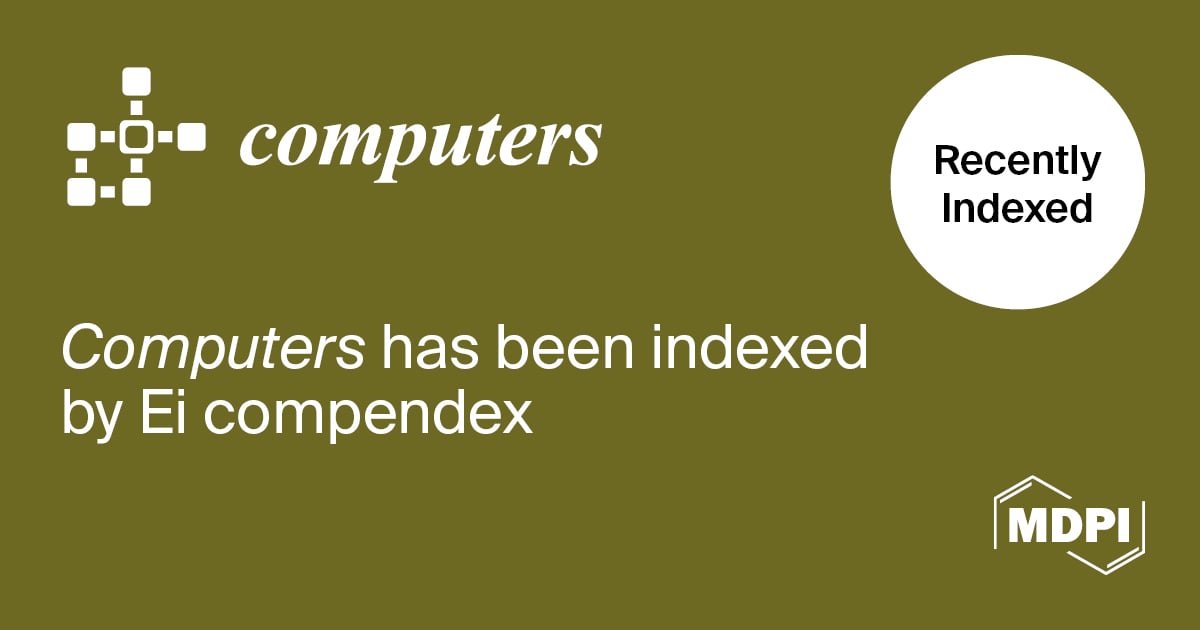-
 Cybercrime Resilience in the Era of Advanced Technologies: Evidence from the Financial Sector of a Developing Country
Cybercrime Resilience in the Era of Advanced Technologies: Evidence from the Financial Sector of a Developing Country -
 A Literature Review on Security in the Internet of Things: Identifying and Analysing Critical Categories
A Literature Review on Security in the Internet of Things: Identifying and Analysing Critical Categories -
 Machine Learning and Deep Learning Paradigms: From Techniques to Practical Applications and Research Frontiers
Machine Learning and Deep Learning Paradigms: From Techniques to Practical Applications and Research Frontiers
Journal Description
Computers
Computers
is an international, scientific, peer-reviewed, open access journal of computer science, including computer and network architecture and computer–human interaction as its main foci, published monthly online by MDPI.
- Open Access— free for readers, with article processing charges (APC) paid by authors or their institutions.
- High Visibility: indexed within Scopus, ESCI (Web of Science), dblp, Inspec, Ei Compendex, and other databases.
- Journal Rank: JCR - Q2 (Computer Science, Interdisciplinary Applications) / CiteScore - Q2 (Computer Networks and Communications)
- Rapid Publication: manuscripts are peer-reviewed and a first decision is provided to authors approximately 15.5 days after submission; acceptance to publication is undertaken in 3.8 days (median values for papers published in this journal in the second half of 2024).
- Recognition of Reviewers: reviewers who provide timely, thorough peer-review reports receive vouchers entitling them to a discount on the APC of their next publication in any MDPI journal, in appreciation of the work done.
Impact Factor:
2.6 (2023);
5-Year Impact Factor:
2.4 (2023)
Latest Articles
Use of Explainable Artificial Intelligence for Analyzing and Explaining Intrusion Detection Systems
Computers 2025, 14(5), 160; https://doi.org/10.3390/computers14050160 - 25 Apr 2025
Abstract
The increase in malicious cyber activities has generated the need to produce effective tools for the field of digital forensics and incident response. Artificial intelligence (AI) and its fields, specifically machine learning (ML) and deep learning (DL), have shown great potential to aid
[...] Read more.
The increase in malicious cyber activities has generated the need to produce effective tools for the field of digital forensics and incident response. Artificial intelligence (AI) and its fields, specifically machine learning (ML) and deep learning (DL), have shown great potential to aid the task of processing and analyzing large amounts of information. However, models generated by DL are often considered “black boxes”, a name derived due to the difficulties faced by users when trying to understand the decision-making process for obtaining results. This research seeks to address the challenges of transparency, explainability, and reliability posed by black-box models in digital forensics. To accomplish this, explainable artificial intelligence (XAI) is explored as a solution. This approach seeks to make DL models more interpretable and understandable by humans. The SHAP (SHapley Additive eXplanations) and LIME (Local Interpretable Model-agnostic Explanations) methods will be implemented and evaluated as a model-agnostic technique to explain predictions of the generated models for forensic analysis. By applying these methods to the XGBoost and TabNet models trained on the UNSW-NB15 dataset, the results indicated distinct global feature importance rankings between the model types and revealed greater consistency of local explanations for the tree-based XGBoost model compared to the deep learning-based TabNet. This study aims to make the decision-making process in these models transparent and to assess the confidence and consistency of XAI-generated explanations in a forensic context.
Full article
(This article belongs to the Special Issue Using New Technologies in Cyber Security Solutions (2nd Edition))
►
Show Figures
Open AccessArticle
Fine-Tuning Network Slicing in 5G: Unveiling Mathematical Equations for Precision Classification
by
Nikola Anđelić, Sandi Baressi Šegota and Vedran Mrzljak
Computers 2025, 14(5), 159; https://doi.org/10.3390/computers14050159 - 25 Apr 2025
Abstract
Modern 5G network slicing centers on the precise design of virtual, independent networks operating over a shared physical infrastructure, each configured to meet specific service requirements. This approach plays a vital role in enabling highly customized and flexible service delivery within the 5G
[...] Read more.
Modern 5G network slicing centers on the precise design of virtual, independent networks operating over a shared physical infrastructure, each configured to meet specific service requirements. This approach plays a vital role in enabling highly customized and flexible service delivery within the 5G ecosystem. In this study, we present the application of a genetic programming symbolic classifier to a dedicated network slicing dataset, resulting in the generation of accurate symbolic expressions for classifying different network slice types. To address the issue of class imbalance, we employ oversampling strategies that produce balanced variations of the dataset. Furthermore, a random search strategy is used to explore the hyperparameter space comprehensively in pursuit of optimal classification performance. The derived symbolic models, refined through threshold tuning based on prediction correctness, are subsequently evaluated on the original imbalanced dataset. The proposed method demonstrates outstanding performance, achieving a perfect classification accuracy of 1.0.
Full article
(This article belongs to the Special Issue Distributed Computing Paradigms for the Internet of Things: Exploring Cloud, Edge, and Fog Solutions)
►▼
Show Figures
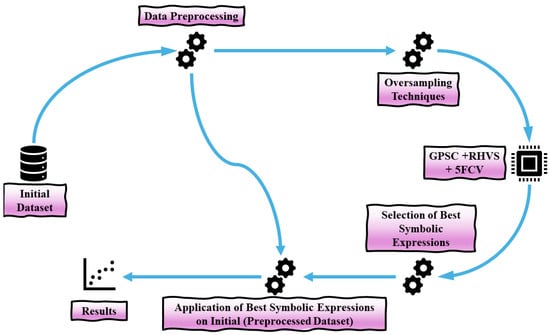
Figure 1
Open AccessArticle
PyChatAI: Enhancing Python Programming Skills—An Empirical Study of a Smart Learning System
by
Manal Alanazi, Ben Soh, Halima Samra and Alice Li
Computers 2025, 14(5), 158; https://doi.org/10.3390/computers14050158 - 23 Apr 2025
Abstract
This paper presents strategies for effectively integrating AI tools into programming education and provides recommendations for enhancing student learning outcomes through intelligent educational systems. Learning computer programming is a cognitively demanding task that requires dedication, logical reasoning, and persistence. Many beginners struggle with
[...] Read more.
This paper presents strategies for effectively integrating AI tools into programming education and provides recommendations for enhancing student learning outcomes through intelligent educational systems. Learning computer programming is a cognitively demanding task that requires dedication, logical reasoning, and persistence. Many beginners struggle with debugging and often lack effective problem-solving strategies. To address these issues, this study investigates PyChatAI—a bilingual, AI-powered chatbot designed to support novice Python programmers by providing real-time feedback, answering coding-related questions, and fostering independent problem-solving skills. PyChatAI offers continuous, personalised assistance and is particularly beneficial for students who prefer remote or low-pressure learning environments. An empirical evaluation employing a Solomon Four-Group design revealed significant improvements across all programming skill areas, with especially strong gains in theoretical understanding, code writing, and debugging proficiency.
Full article
(This article belongs to the Special Issue Smart Learning Environments)
►▼
Show Figures

Figure 1
Open AccessArticle
Advanced Digital System for International Collaboration on Biosample-Oriented Research: A Multicriteria Query Tool for Real-Time Biosample and Patient Cohort Searches
by
Alexandros Fridas, Anna Bourouliti, Loukia Touramanidou, Desislava Ivanova, Kostantinos Votis and Panagiotis Katsaounis
Computers 2025, 14(5), 157; https://doi.org/10.3390/computers14050157 - 23 Apr 2025
Abstract
The advancement of biomedical research depends on efficient data sharing, integration, and annotation to ensure reproducibility, accessibility, and cross-disciplinary collaboration. International collaborative research is crucial for advancing biomedical science and innovation but often faces significant barriers, such as data sharing limitations, inefficient sample
[...] Read more.
The advancement of biomedical research depends on efficient data sharing, integration, and annotation to ensure reproducibility, accessibility, and cross-disciplinary collaboration. International collaborative research is crucial for advancing biomedical science and innovation but often faces significant barriers, such as data sharing limitations, inefficient sample management, and scalability challenges. Existing infrastructures for biosample and data repositories face challenges limiting large-scale research efforts. This study presents a novel platform designed to address these issues, enabling researchers to conduct high-quality research more efficiently and at reduced costs. The platform employs a modular, distributed architecture that ensures high availability, redundancy, and interoperability among diverse stakeholders, as well as integrates advanced features, including secure access management, comprehensive query functionalities, real-time availability reporting, and robust data mining capabilities. In addition, this platform supports dynamic, multi-criteria searches tailored to disease-specific patient profiles and biosample-related data across pre-analytical, post-analytical, and cryo-storage processes. By evaluating the platform’s modular architecture and pilot testing outcomes, this study demonstrates its potential to enhance interdisciplinary collaboration, streamline research workflows, and foster transformative advancements in biomedical research. The key is the innovation of a real-time dynamic e-consent (DRT e-consent) system, which allows donors to update their consent status in real time, ensuring compliance with ethical and regulatory frameworks such as GDPR and HIPAA. The system also supports multi-modal data integration, including genomic sequences, electronic health records (EHRs), and imaging data, enabling researchers to perform complex queries and generate comprehensive insights.
Full article
(This article belongs to the Special Issue Future Systems Based on Healthcare 5.0 for Pandemic Preparedness 2024)
►▼
Show Figures
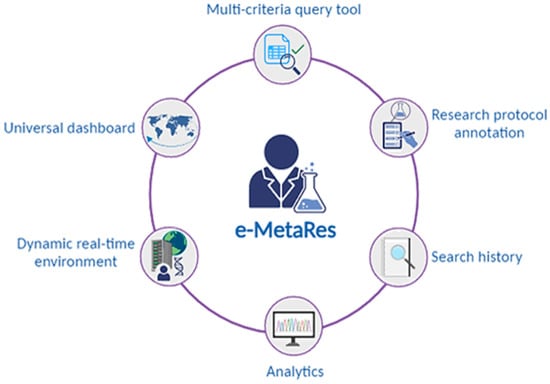
Figure 1
Open AccessArticle
Students Collaboratively Prompting ChatGPT
by
Maria Perifanou and Anastasios A. Economides
Computers 2025, 14(5), 156; https://doi.org/10.3390/computers14050156 - 22 Apr 2025
Abstract
This study investigated how undergraduate students collaborated when working with ChatGPT and what teamwork approaches they used, focusing on students’ preferences, conflict resolution, reliance on AI-generated content, and perceived learning outcomes. In a course on the Applications of Information Systems, 153 undergraduate students
[...] Read more.
This study investigated how undergraduate students collaborated when working with ChatGPT and what teamwork approaches they used, focusing on students’ preferences, conflict resolution, reliance on AI-generated content, and perceived learning outcomes. In a course on the Applications of Information Systems, 153 undergraduate students were organized into teams of 3. Team members worked together to create a report and a presentation on a specific data mining technique, exploiting ChatGPT, internet resources, and class materials. The findings revealed no strong preference for a single collaborative mode, though Modes #2, #4, and #5 were marginally favored due to clearer structures, role clarity, or increased individual autonomy. Students reasonably encountered initial disagreements (averaging 30.44%), which were eventually resolved—indicating constructive debates that improve critical thinking. Data also showed that students moderately modified ChatGPT’s responses (50% on average) and based nearly half (44%) of their overall output on AI-generated content, suggesting a balanced yet varied level of reliance on AI. Notably, a statistically significant relationship emerged between students’ perceived learning and actual performance, implying that self-assessment can complement objective academic measures. Students also employed a diverse mix of communication tools, from synchronous (phone calls) to asynchronous (Instagram) and collaborative platforms (Google Drive), valuing their ease of use but facing scheduling, technical, and engagement issues. Overall, these results reveal the need for flexible collaborative patterns, more supportive AI use policies, and versatile communication methods so that educators can apply collaborative learning effectively and maintain academic integrity.
Full article
(This article belongs to the Special Issue Transformative Approaches in Education: Harnessing AI, Augmented Reality, and Virtual Reality for Innovative Teaching and Learning)
►▼
Show Figures
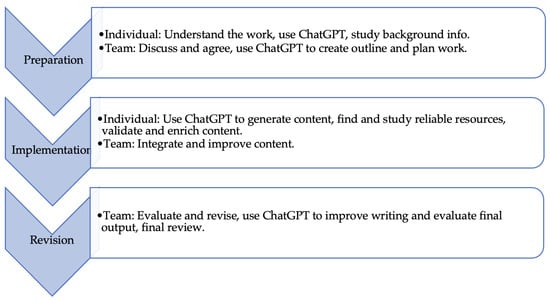
Figure 1
Open AccessArticle
The Ubimus Plugging Framework: Deploying FPGA-Based Prototypes for Ubiquitous Music Hardware Design
by
Damián Keller, Aman Jagwani and Victor Lazzarini
Computers 2025, 14(4), 155; https://doi.org/10.3390/computers14040155 - 21 Apr 2025
Abstract
►▼
Show Figures
The emergent field of embedded computing presents a challenging scenario for ubiquitous music (ubimus) design. Available tools demand specific technical knowledge—as exemplified in the techniques involved in programming integrated circuits of configurable logic units, known as field-programmable gate arrays (FPGAs). Low-level hardware description
[...] Read more.
The emergent field of embedded computing presents a challenging scenario for ubiquitous music (ubimus) design. Available tools demand specific technical knowledge—as exemplified in the techniques involved in programming integrated circuits of configurable logic units, known as field-programmable gate arrays (FPGAs). Low-level hardware description languages used for handling FPGAs involve a steep learning curve. Hence, FPGA programming offers a unique challenge to probe the boundaries of ubimus frameworks as enablers of fast and versatile prototyping. State-of-the-art hardware-oriented approaches point to the use of high-level synthesis as a promising programming technique. Furthermore, current FPGA system-on-chip (SoC) hardware with an associated onboard general-purpose processor may foster the development of flexible platforms for musical signal processing. Taking into account the emergence of an FPGA-based ecology of tools, we introduce the ubimus plugging framework. The procedures employed in the construction of a modular- synthesis library based on field-programmable gate array hardware, ModFPGA, are documented, and examples of musical projects applying key design principles are discussed.
Full article
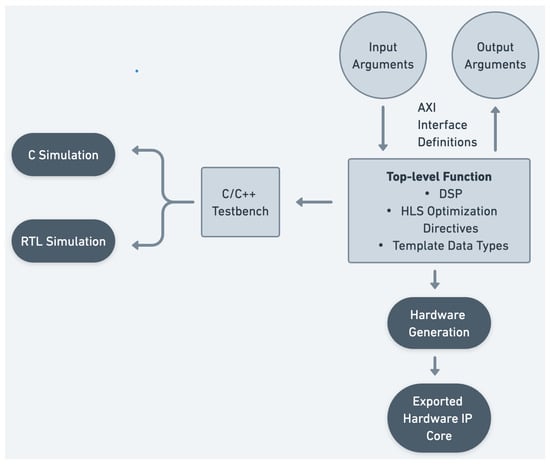
Figure 1
Open AccessArticle
Generative Artificial Intelligence as a Catalyst for Change in Higher Education Art Study Programs
by
Anna Ansone, Zinta Zālīte-Supe and Linda Daniela
Computers 2025, 14(4), 154; https://doi.org/10.3390/computers14040154 - 20 Apr 2025
Abstract
Generative Artificial Intelligence (AI) has emerged as a transformative tool in art education, offering innovative avenues for creativity and learning. However, concerns persist among educators regarding the potential misuse of text-to-image generators as unethical shortcuts. This study explores how bachelor’s-level art students perceive
[...] Read more.
Generative Artificial Intelligence (AI) has emerged as a transformative tool in art education, offering innovative avenues for creativity and learning. However, concerns persist among educators regarding the potential misuse of text-to-image generators as unethical shortcuts. This study explores how bachelor’s-level art students perceive and use generative AI in artistic composition. Ten art students participated in a lecture on composition principles and completed a practical composition task using both traditional methods and generative AI tools. Their interactions were observed, followed by the administration of a questionnaire capturing their reflections. Qualitative analysis of the data revealed that students recognize the potential of generative AI for ideation and conceptual development but find its limitations frustrating for executing nuanced artistic tasks. This study highlights the current utility of generative AI as an inspirational and conceptual mentor rather than a precise artistic tool, highlighting the need for structured training and a balanced integration of generative AI with traditional design methods. Future research should focus on larger participant samples, assess the evolving capabilities of generative AI tools, and explore their potential to teach fundamental art concepts effectively while addressing concerns about academic integrity. Enhancing the functionality of these tools could bridge gaps between creativity and pedagogy in art education.
Full article
(This article belongs to the Special Issue Smart Learning Environments)
►▼
Show Figures
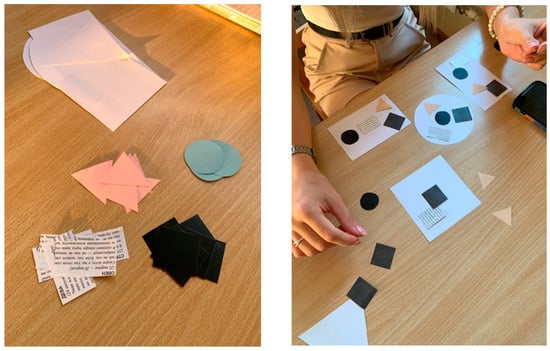
Figure 1
Open AccessArticle
Design of an Emotional Facial Recognition Task in a 3D Environment
by
Gemma Quirantes-Gutierrez, Ángeles F. Estévez, Gabriel Artés Ordoño and Ginesa López-Crespo
Computers 2025, 14(4), 153; https://doi.org/10.3390/computers14040153 - 18 Apr 2025
Abstract
The recognition of emotional facial expressions is a key skill for social adaptation. Previous studies have shown that clinical and subclinical populations, such as those diagnosed with schizophrenia or autism spectrum disorder, have a significant deficit in the recognition of emotional facial expressions.
[...] Read more.
The recognition of emotional facial expressions is a key skill for social adaptation. Previous studies have shown that clinical and subclinical populations, such as those diagnosed with schizophrenia or autism spectrum disorder, have a significant deficit in the recognition of emotional facial expressions. These studies suggest that this may be the cause of their social dysfunction. Given the importance of this type of recognition in social functioning, the present study aims to design a tool to measure the recognition of emotional facial expressions using Unreal Engine 4 software to develop computer graphics in a 3D environment. Additionally, we tested it in a small pilot study with a sample of 37 university students, aged between 18 and 40, to compare the results with a more classical emotional facial recognition task. We also administered the SEES Scale and a set of custom-formulated questions to both groups to assess potential differences in activation levels between the two modalities (3D environment vs. classical format). The results of this initial pilot study suggest that students who completed the task in the classical format exhibited a greater lack of activation compared to those who completed the task in the 3D environment. Regarding the recognition of emotional facial expressions, both tasks were similar in two of the seven emotions evaluated. We believe that this study represents the beginning of a new line of research that could have important clinical implications.
Full article
(This article belongs to the Special Issue Multimodal Pattern Recognition of Social Signals in HCI (2nd Edition))
►▼
Show Figures
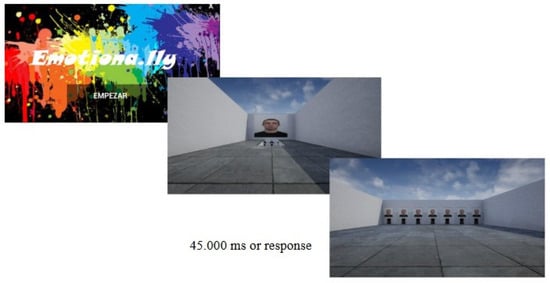
Figure 1
Open AccessArticle
Role of Roadside Units in Cluster Head Election and Coverage Maximization for Vehicle Emergency Services
by
Ravneet Kaur, Robin Doss, Lei Pan, Chaitanya Singla and Selvarajah Thuseethan
Computers 2025, 14(4), 152; https://doi.org/10.3390/computers14040152 - 18 Apr 2025
Abstract
Efficient clustering algorithms are critical for enabling the timely dissemination of emergency messages across maximum coverage areas in vehicular networks. While existing clustering approaches demonstrate stability and scalability, there has been a limited amount of work focused on leveraging roadside units (RSUs) for
[...] Read more.
Efficient clustering algorithms are critical for enabling the timely dissemination of emergency messages across maximum coverage areas in vehicular networks. While existing clustering approaches demonstrate stability and scalability, there has been a limited amount of work focused on leveraging roadside units (RSUs) for cluster head selection. This research proposes a novel framework that utilizes RSUs to facilitate cluster head election, mitigating the cluster head selection process, clustering overhead, and broadcast storm problem. The proposed scheme mandates selecting an optimal number of cluster heads to maximize information coverage and prevent traffic congestion, thereby enhancing the quality of service through improved cluster head duration, reduced cluster formation time, expanded coverage area, and decreased overhead. The framework comprises three key components: (I) an acknowledgment-based system for legitimate vehicle entry into the RSU for cluster head selection; (II) an authoritative node behavior mechanism for choosing cluster heads from received notifications; and (III) the role of bridge nodes in maximizing the coverage of the established network. The comparative analysis evaluates the clustering framework’s performance under uniform and non-uniform vehicle speed scenarios for time-barrier-based emergency message dissemination in vehicular ad hoc networks. The results demonstrate that the proposed model’s effectiveness for uniform highway speed scenarios is 100% whereas for non-uniform scenarios 99.55% information coverage is obtained. Furthermore, the clustering process accelerates by over 50%, decreasing overhead and reducing cluster head election time using RSUs. The proposed approach outperforms existing methods for the number of cluster heads, cluster head election time, total cluster formation time, and maximum information coverage across varying vehicle densities.
Full article
(This article belongs to the Special Issue Emerging Trends in Machine Learning and Artificial Intelligence)
►▼
Show Figures
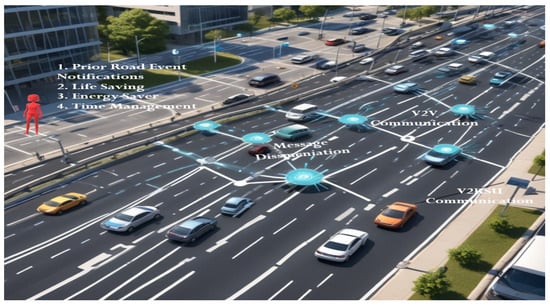
Figure 1
Open AccessArticle
Kalman Filter-Enhanced Data Aggregation in LoRaWAN-Based IoT Framework for Aquaculture Monitoring in Sargassum sp. Cultivation
by
Misbahuddin Misbahuddin, Nunik Cokrowati, Muhamad Syamsu Iqbal, Obie Farobie, Apip Amrullah and Lusi Ernawati
Computers 2025, 14(4), 151; https://doi.org/10.3390/computers14040151 - 18 Apr 2025
Abstract
This study presents a LoRaWAN-based IoT framework for robust data aggregation in Sargassum sp. cultivation, integrating multi-sensor monitoring and Kalman filter-based data enhancement. The system employs water quality sensors—including temperature, salinity, light intensity, dissolved oxygen, total dissolved solids, and pH—deployed in 6 out
[...] Read more.
This study presents a LoRaWAN-based IoT framework for robust data aggregation in Sargassum sp. cultivation, integrating multi-sensor monitoring and Kalman filter-based data enhancement. The system employs water quality sensors—including temperature, salinity, light intensity, dissolved oxygen, total dissolved solids, and pH—deployed in 6 out of 14 cultivation containers. Sensor data are transmitted via LoRaWAN to The Things Network (TTN) and processed through an MQTT-based pipeline in Node-RED before visualization in ThingSpeak. The Kalman filter is applied to improve data accuracy and detect faulty sensor readings, ensuring reliable aggregation of environmental parameters. Experimental results demonstrate that this approach effectively maintains optimal cultivation conditions, reducing ecological risks such as eutrophication and improving Sargassum sp. growth monitoring. Findings indicate that balanced light intensity plays a crucial role in photosynthesis, with optimally exposed containers exhibiting the highest survival rates and biomass. However, nutrient supplementation showed limited impact due to uneven distribution, highlighting the need for improved delivery systems. By combining real-time monitoring with advanced data processing, this framework enhances decision-making in sustainable aquaculture, demonstrating the potential of LoRaWAN and Kalman filter-based methodologies for environmental monitoring and resource management.
Full article
(This article belongs to the Special Issue The Internet of Things—Current Trends, Applications, and Future Challenges (2nd Edition))
►▼
Show Figures
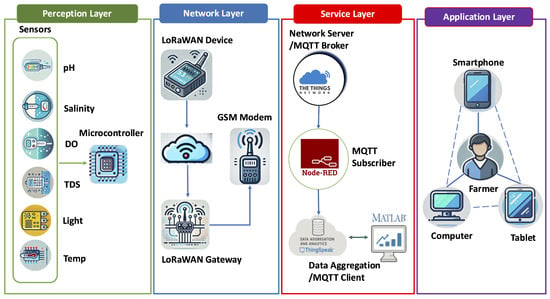
Figure 1
Open AccessSystematic Review
A Systematic Literature Review of Machine Unlearning Techniques in Neural Networks
by
Ivanna Daniela Cevallos, Marco E. Benalcázar, Ángel Leonardo Valdivieso Caraguay, Jonathan A. Zea and Lorena Isabel Barona-López
Computers 2025, 14(4), 150; https://doi.org/10.3390/computers14040150 - 18 Apr 2025
Abstract
This review examines the field of machine unlearning in neural networks, an area driven by data privacy regulations such as the General Data Protection Regulation and the California Consumer Privacy Act. By analyzing 37 primary studies of machine unlearning applied to neural networks
[...] Read more.
This review examines the field of machine unlearning in neural networks, an area driven by data privacy regulations such as the General Data Protection Regulation and the California Consumer Privacy Act. By analyzing 37 primary studies of machine unlearning applied to neural networks in both regression and classification tasks, this review thoroughly evaluates the foundational principles, key performance metrics, and methodologies used to assess these techniques. Special attention is given to recent advancements up to December 2023, including emerging approaches and frameworks. By categorizing and detailing these unlearning techniques, this work offers deeper insights into their evolution, effectiveness, efficiency, and broader applicability, thus providing a solid foundation for future research, development, and practical implementations in the realm of data privacy, model management, and compliance with evolving legal standards. Additionally, this review addresses the challenges of selectively removing data contributions at both the client and instance levels, highlighting the balance between computational costs and privacy guarantees.
Full article
(This article belongs to the Special Issue Uncertainty-Aware Artificial Intelligence)
►▼
Show Figures

Figure 1
Open AccessArticle
Enhancing Smart Home Efficiency with Heuristic-Based Energy Optimization
by
Yasir Abbas Khan, Faris Kateb, Ateeq Ur Rehman, Atif Sardar Khan, Fazal Qudus Khan, Sadeeq Jan and Ali Naser Alkhathlan
Computers 2025, 14(4), 149; https://doi.org/10.3390/computers14040149 - 16 Apr 2025
Abstract
In smart homes, heavy reliance on appliance automation has increased, along with the energy demand in developing urban areas, making efficient energy management an important factor. To address the scheduling of appliances under Demand-Side Management, this article explores the use of heuristic-based optimization
[...] Read more.
In smart homes, heavy reliance on appliance automation has increased, along with the energy demand in developing urban areas, making efficient energy management an important factor. To address the scheduling of appliances under Demand-Side Management, this article explores the use of heuristic-based optimization techniques (HOTs) in smart homes (SHs) equipped with renewable and sustainable energy resources (RSERs) and energy storage systems (ESSs). The optimal model for minimization of the peak-to-average ratio (PAR), considering user comfort constraints, is validated by using different techniques, such as the Genetic Algorithm (GA), Binary Particle Swarm Optimization (BPSO), Wind-Driven Optimization (WDO), Bacterial Foraging Optimization (BFO) and the Genetic Modified Particle Swarm Optimization (GmPSO) algorithm, to minimize electricity costs, the PAR, carbon emissions and delay discomfort. This research investigates the energy optimization results of three real-world scenarios. The three scenarios demonstrate the benefits of gradually assembling RSERs and ESSs and integrating them into SHs employing HOTs. The simulation results show substantial outcomes, as in the scenario of Condition 1, GmPSO decreased carbon emissions from 300 kg to 69.23 kg, reducing emissions by 76.9%; bill prices were also cut from an unplanned value of 400.00 cents to 150 cents, a 62.5% reduction. The PAR was decreased from an unscheduled value of 4.5 to 2.2 with the GmPSO algorithm, which reduced the value by 51.1%. The scenario of Condition 2 showed that GmPSO reduced the PAR from 0.5 (unscheduled) to 0.2, a 60% reduction; the costs were reduced from 500.00 cents to 200.00 cents, a 60% reduction; and carbon emissions were reduced from 250.00 kg to 150 kg, a 60% reduction by GmPSO. In the scenario of Condition 3, where batteries and RSERs were integrated, the GmPSO algorithm reduced the carbon emission value to 158.3 kg from an unscheduled value of 208.3 kg, a reduction of 24%. The energy cost was decreased from an unplanned value of 500 cents to 300 cents with GmPSO, decreasing the overall cost by 40%. The GmPSO algorithm achieved a 57.1% reduction in the PAR value from an unscheduled value of 2.8 to 1.2.
Full article
(This article belongs to the Special Issue Artificial Intelligence-Driven Innovations in Resilient Energy Systems)
►▼
Show Figures

Figure 1
Open AccessReview
Advancing Predictive Healthcare: A Systematic Review of Transformer Models in Electronic Health Records
by
Azza Mohamed, Reem AlAleeli and Khaled Shaalan
Computers 2025, 14(4), 148; https://doi.org/10.3390/computers14040148 - 14 Apr 2025
Abstract
This systematic study seeks to evaluate the use and impact of transformer models in the healthcare domain, with a particular emphasis on their usefulness in tackling key medical difficulties and performing critical natural language processing (NLP) functions. The research questions focus on how
[...] Read more.
This systematic study seeks to evaluate the use and impact of transformer models in the healthcare domain, with a particular emphasis on their usefulness in tackling key medical difficulties and performing critical natural language processing (NLP) functions. The research questions focus on how these models can improve clinical decision-making through information extraction and predictive analytics. Our findings show that transformer models, especially in applications like named entity recognition (NER) and clinical data analysis, greatly increase the accuracy and efficiency of processing unstructured data. Notably, case studies demonstrated a 30% boost in entity recognition accuracy in clinical notes and a 90% detection rate for malignancies in medical imaging. These contributions emphasize the revolutionary potential of transformer models in healthcare, and therefore their importance in enhancing resource management and patient outcomes. Furthermore, this paper emphasizes significant obstacles, such as the reliance on restricted datasets and the need for data format standardization, and provides a road map for future research to improve the applicability and performance of these models in real-world clinical settings.
Full article
(This article belongs to the Special Issue Applications of Machine Learning and Artificial Intelligence for Healthcare)
►▼
Show Figures

Figure 1
Open AccessArticle
An Approach to Thermal Management and Performance Throttling for Federated Computation on a Low-Cost 3D ESP32-S3 Package Stack
by
Yi Liu, Parth Sandeepbhai Shah, Tian Xia and Dryver Huston
Computers 2025, 14(4), 147; https://doi.org/10.3390/computers14040147 - 11 Apr 2025
Abstract
►▼
Show Figures
The rise of 3D heterogeneous packaging holds promise for increased performance in applications such as AI by bringing compute and memory modules into close proximity. This increased performance comes with increased thermal management challenges. This research explores the use of thermal sensing and
[...] Read more.
The rise of 3D heterogeneous packaging holds promise for increased performance in applications such as AI by bringing compute and memory modules into close proximity. This increased performance comes with increased thermal management challenges. This research explores the use of thermal sensing and load throttling combined with federated computation to manage localized internal heating in a multi-3D chip package. The overall concept is that individual chiplets may heat at different rates due to operational and geometric factors. Shifting computational loads from hot to cooler chiplets can prevent local overheating while maintaining overall computational output. This concept is verified with experiments in a low-cost test vehicle. The test vehicle mimics a 3D chiplet stack with a tightly stacked assembly of SoC devices. These devices can sense and report internal temperature and dynamically adjust frequency. The configuration is for ESP32-S3 microcontrollers to work on a federated computational task, while reporting internal temperature to a host controller. The tight packing of processors causes temperatures to rise, with those internal to the stack rising more quickly than external ones. With real-time temperature monitoring, when the temperatures exceed a threshold, the AI system reduces the processor frequency, i.e., throttles the processor, to save power and dynamically shifts part of the workload to other ESP32-S3s with lower temperatures. This approach maximizes overall efficiency while maintaining thermal safety without compromising computational power. Experimental results with up to six processors confirm the validity of the concept.
Full article

Figure 1
Open AccessArticle
Review of Maturity Models for Data Mining and Proposal of a Data Preparation Maturity Model Prototype for Data Mining
by
Florian Hochkamp, Anne Antonia Scheidler and Markus Rabe
Computers 2025, 14(4), 146; https://doi.org/10.3390/computers14040146 - 11 Apr 2025
Abstract
Companies face uncertainties evaluating their own capabilities when implementing data analytics or data mining. Data mining is a valuable process used to analyze data and support decisions based on the knowledge generated, creating a pipeline from the phases of data collection to data
[...] Read more.
Companies face uncertainties evaluating their own capabilities when implementing data analytics or data mining. Data mining is a valuable process used to analyze data and support decisions based on the knowledge generated, creating a pipeline from the phases of data collection to data preparation and data mining. In order to assess the target state of a company in terms of its data mining capabilities, maturity models are viable tools. However, no maturity models exist that focus on the data mining process and its particular phases. This article discusses existing maturity models in the broader field of data mining, such as data management, machine learning, or artificial intelligence. Focusing on the most cost-relevant phase of data preparation, the critical influences for the development of a maturity model for the phase of data preparation are identified and categorized. Additionally, a data preparation maturity model prototype is proposed. This provides the first step towards the design of a maturity model for data mining.
Full article
(This article belongs to the Special Issue IT in Production and Logistics)
►▼
Show Figures

Figure 1
Open AccessReview
Comparison of Bioelectric Signals and Their Applications in Artificial Intelligence: A Review
by
Juarez-Castro Flavio Alfonso, Toledo-Rios Juan Salvador, Aceves-Fernández Marco Antonio and Tovar-Arriaga Saul
Computers 2025, 14(4), 145; https://doi.org/10.3390/computers14040145 - 11 Apr 2025
Abstract
►▼
Show Figures
This review examines the role of various bioelectrical signals in conjunction with artificial intelligence (AI) and analyzes how these signals are utilized in AI applications. The applications of electroencephalography (EEG), electroretinography (ERG), electromyography (EMG), electrooculography (EOG), and electrocardiography (ECG) in diagnostic and therapeutic
[...] Read more.
This review examines the role of various bioelectrical signals in conjunction with artificial intelligence (AI) and analyzes how these signals are utilized in AI applications. The applications of electroencephalography (EEG), electroretinography (ERG), electromyography (EMG), electrooculography (EOG), and electrocardiography (ECG) in diagnostic and therapeutic systems are focused on. Signal processing techniques are discussed, and relevant studies that have utilized these signals in various clinical and research settings are highlighted. Advances in signal processing and classification methodologies powered by AI have significantly improved accuracy and efficiency in medical analysis. The integration of AI algorithms with bioelectrical signal processing for real-time monitoring and diagnosis, particularly in personalized medicine, is emphasized. AI-driven approaches are shown to have the potential to enhance diagnostic precision and improve patient outcomes. However, further research is needed to optimize these models for diverse clinical environments and fully exploit the interaction between bioelectrical signals and AI technologies.
Full article

Figure 1
Open AccessArticle
Towards a Better Understanding of Mobile Banking App Adoption and Use: Integrating Security, Risk, and Trust into UTAUT2
by
Richard Apau, Elzbieta Titis and Harjinder Singh Lallie
Computers 2025, 14(4), 144; https://doi.org/10.3390/computers14040144 - 10 Apr 2025
Abstract
This paper expands the extended unified theory of acceptance and use of technology (UTAUT2) to include four additional constructs (security, risk, institutional trust, and technology trust), providing a more comprehensive understanding of mobile banking applications (m-banking apps) adoption. It also highlights the significant
[...] Read more.
This paper expands the extended unified theory of acceptance and use of technology (UTAUT2) to include four additional constructs (security, risk, institutional trust, and technology trust), providing a more comprehensive understanding of mobile banking applications (m-banking apps) adoption. It also highlights the significant role of demographic factors in moderating the impact of these constructs, offering practical insights for promoting the use of mobile devices to access and manage banking services. Data were collected using an online survey from 315 mobile banking users and analysed using covariance-based structural equation modelling (CB-SEM). Most constructs of the baseline UTAUT2 were validated in the m-banking context, with the additional constructs confirmed to affect user intention to adopt m-banking apps, except perceived risk. The model explained 79% of the variance in behavioural intention (BI), and 54.7% in use behaviour (UB), achieving higher fit than the baseline UTAUT2. Age, gender, experience, income, and education moderated the impact of perceived security and institutional trust on BI; age, education, and experience moderated technology trust on BI; and age, gender, and experience moderated perceived security on UB. The guarantee of enhanced security, advanced privacy mechanisms, and trust should be considered paramount in future strategies aimed at promoting m-banking app adoption and use. Overall, the paper advances scientific knowledge by providing a more nuanced and comprehensive framework for understanding m-banking app adoption, validating new constructs, and offering practical recommendations for promoting m-banking usage.
Full article
(This article belongs to the Special Issue Multimedia Data and Network Security)
►▼
Show Figures
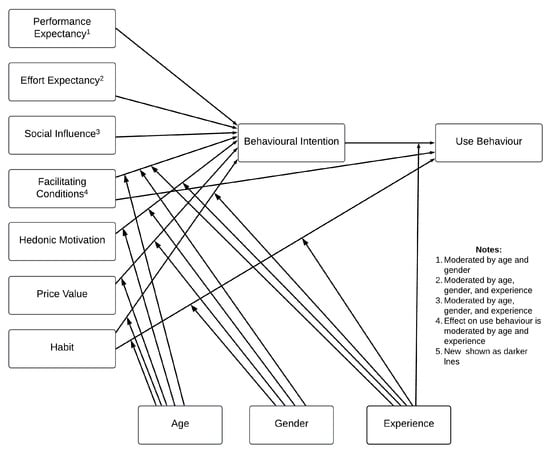
Figure 1
Open AccessReview
A State-of-the-Art Review of Artificial Intelligence (AI) Applications in Healthcare: Advances in Diabetes, Cancer, Epidemiology, and Mortality Prediction
by
Mariano Vargas-Santiago, Diana Assaely León-Velasco, Christian Efraín Maldonado-Sifuentes and Liliana Chanona-Hernandez
Computers 2025, 14(4), 143; https://doi.org/10.3390/computers14040143 - 10 Apr 2025
Abstract
Artificial Intelligence (AI) methodologies have profoundly influenced healthcare research, particularly in chronic disease management and public health. This paper provides a comprehensive state-of-the-art review of AI’s applications across diabetes, cancer, epidemiology, and mortality prediction. The analysis highlights advancements in machine learning (ML), deep
[...] Read more.
Artificial Intelligence (AI) methodologies have profoundly influenced healthcare research, particularly in chronic disease management and public health. This paper provides a comprehensive state-of-the-art review of AI’s applications across diabetes, cancer, epidemiology, and mortality prediction. The analysis highlights advancements in machine learning (ML), deep learning (DL), and natural language processing (NLP) that enable robust predictive models and decision support systems, leading to significant clinical and public health outcomes. The study examines predictive modeling, pattern recognition, and decision support applications, addressing their respective challenges and potential in real-world healthcare settings. Emphasis is placed on the emerging role of explainable AI (XAI), multimodal data fusion, and privacy-preserving techniques such as federated learning, which aim to enhance interpretability, robustness, and ethical compliance. This paper underscores the vital role of interdisciplinary collaboration and adaptive AI systems in creating resilient, scalable, and patient-centric healthcare solutions.
Full article
(This article belongs to the Special Issue Applications of Machine Learning and Artificial Intelligence for Healthcare)
Open AccessArticle
An Innovative Approach to Topic Clustering for Social Media and Web Data Using AI
by
Ioannis Kapantaidakis, Emmanouil Perakakis, George Mastorakis and Ioannis Kopanakis
Computers 2025, 14(4), 142; https://doi.org/10.3390/computers14040142 - 10 Apr 2025
Abstract
The vast amount of social media and web data offers valuable insights for purposes such as brand reputation management, topic research, competitive analysis, product development, and public opinion surveys. However, analysing these data to identify patterns and extract valuable insights is challenging due
[...] Read more.
The vast amount of social media and web data offers valuable insights for purposes such as brand reputation management, topic research, competitive analysis, product development, and public opinion surveys. However, analysing these data to identify patterns and extract valuable insights is challenging due to the vast number of posts, which can number in the thousands within a single day. One practical approach is topic clustering, which creates clusters of mentions that refer to a specific topic. Following this process will create several manageable clusters, each containing hundreds or thousands of posts. These clusters offer a more meaningful overview of the discussed topics, eliminating the need to categorise each post manually. Several topic detection algorithms can achieve clustering of posts, such as LDA, NMF, BERTopic, etc. The existing algorithms, however, have several important drawbacks, including language constraints and slow or resource-intensive data processing. Moreover, the labels for the clusters typically consist of a few keywords that may not make sense unless one explores the mentions within the cluster. Recently, with the introduction of AI large language models, such as GPT-4, new techniques can be realised for topic clustering to address the aforementioned issues. Our novel approach (AI Mention Clustering) employs LLMs at its core to produce an algorithm for efficient and accurate topic clustering of web and social data. Our solution was tested on social and web data and compared to the popular existing algorithm of BERTopic, demonstrating superior resource efficiency and absolute accuracy of clustered documents. Furthermore, it produces summaries of the clusters that are easily understood by humans instead of just representative keywords. This approach enhances the productivity of social and web data researchers by providing more meaningful and interpretable results.
Full article
(This article belongs to the Special Issue Harnessing Artificial Intelligence for Social and Semantic Understanding)
►▼
Show Figures

Figure 1
Open AccessReview
A Systematic Review of Blockchain-Based Initiatives in Comparison to Best Practices Used in Higher Education Institutions
by
Diana Laura Silaghi and Daniela Elena Popescu
Computers 2025, 14(4), 141; https://doi.org/10.3390/computers14040141 - 8 Apr 2025
Abstract
Blockchain technology, originally introduced through Bitcoin cryptocurrency in 2008, has rapidly expanded beyond its financial roots, offering innovative solutions for secure data management across various sectors, including education. Higher education institutions, faced with challenges in managing academic records, verifying degrees, assessing skills, and
[...] Read more.
Blockchain technology, originally introduced through Bitcoin cryptocurrency in 2008, has rapidly expanded beyond its financial roots, offering innovative solutions for secure data management across various sectors, including education. Higher education institutions, faced with challenges in managing academic records, verifying degrees, assessing skills, and safeguarding personal data, have increasingly looked to blockchain for answers. Blockchain’s transparent, immutable, and decentralized nature provides potential solutions to these longstanding problems. This systematic review assesses blockchain-based proposals for academic certificates management, aiming to highlight globally recognized best practices, explore the latest applications, and identify key challenges hindering the widespread adoption of blockchain technology in education. A thorough discussion based on the findings introduces potential solutions to mitigate these challenges and provides insights into possible future research directions that could help overcome these obstacles.
Full article
(This article belongs to the Special Issue Harnessing the Blockchain Technology in Unveiling Futuristic Applications)
►▼
Show Figures

Figure 1
Highly Accessed Articles
Latest Books
E-Mail Alert
News
Topics
Topic in
AI, Buildings, Computers, Drones, Entropy, Symmetry
Applications of Machine Learning in Large-Scale Optimization and High-Dimensional Learning
Topic Editors: Jeng-Shyang Pan, Junzo Watada, Vaclav Snasel, Pei HuDeadline: 30 April 2025
Topic in
Applied Sciences, ASI, Blockchains, Computers, MAKE, Software
Recent Advances in AI-Enhanced Software Engineering and Web Services
Topic Editors: Hai Wang, Zhe HouDeadline: 31 May 2025
Topic in
Applied Sciences, Computers, Electronics, Sensors, Virtual Worlds, IJGI
Simulations and Applications of Augmented and Virtual Reality, 2nd Edition
Topic Editors: Radu Comes, Dorin-Mircea Popovici, Calin Gheorghe Dan Neamtu, Jing-Jing FangDeadline: 20 June 2025
Topic in
Applied Sciences, Automation, Computers, Electronics, Sensors, JCP, Mathematics
Intelligent Optimization, Decision-Making and Privacy Preservation in Cyber–Physical Systems
Topic Editors: Lijuan Zha, Jinliang Liu, Jian LiuDeadline: 31 August 2025

Conferences
Special Issues
Special Issue in
Computers
Smart Learning Environments
Guest Editor: Ananda MaitiDeadline: 30 April 2025
Special Issue in
Computers
Future Trends in Computer Programming Education
Guest Editor: Stelios XinogalosDeadline: 31 May 2025
Special Issue in
Computers
Harnessing the Blockchain Technology in Unveiling Futuristic Applications
Guest Editors: Raman Singh, Shantanu PalDeadline: 15 June 2025
Special Issue in
Computers
Future Systems Based on Healthcare 5.0 for Pandemic Preparedness 2024
Guest Editor: Xuhui ChenDeadline: 30 June 2025






